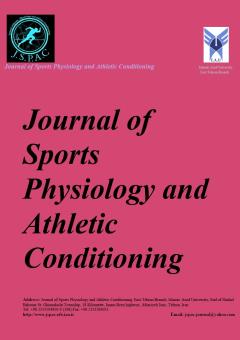Indicators of Specific Performance Test in Judokas versus Wrestlers; A Comparative Study
Subject Areas : Sport PhysiologyAbbas Ghanbari-Niaki 1 , Seyed Ali Khazaei 2 , Nader Hamedchaman 3
1 - Department of Exercise Biochemistry, Faculty of Sport Sciences, University of Mazandaran, Babolsar, Iran
2 - Department of motor behavior and sport psychology, Science and Research Branch, Islamic Azad University,Tehran,Iran
3 - Faculty of Physical Education and Sport Sciences, Shomal University , Amol, Mazandaran, Iran
Keywords: Special Judo Fitness Test, Performance Indicators, Freestyle Wrestling , Judo,
Abstract :
Introduction and Purpose: The aim of this study was to compare performance indicators between judokas and freestyle wrestlers using the Special Judo Fitness Test (SJFT). This test was selected due to its ability to assess muscular endurance and performance in combat sports. Methods: total number of 36 male athletes (25 wrestlers and 11 judokas), aged between 18 - 35 years, who were regularly participated in their practice sessions, recruited for the study and randomly assigned to 2 groups of : (1) Wrestle group (n=25) and (2) Judo group (n=11). Anthropometric variables including height, weight, age, BMI, body fat percentage, as well as performance test of 15 second, first 30 seconds, and 30 seconds throwing count, and also immediate heart rate and heart rate after 1 minute plus the SJFT index were measured. Data were analyzed using independent t-test to compare the mean values between the two groups at a significant level of P<0.05. Results: The results showed significant differences between judokas and wrestlers in some of the measured indicators (P < 0.05). Wrestlers performed better in performance indicators such as 15-second interval (P = 0.004), the first 30-second interval (P = 0.002), and the second 30-second interval (P = 0.001) were significantly higher in the wrestling group compared to the judo group; furthermore, the overall performance index also showed a significant difference between the two groups (P = 0.001). No significant differences were found in BMI, body fat percentage, or heart rate (immediate and 1 minute post-test). Conclusion: The observed differences may be attributed to the distinct nature of training and physiological demands of each sport. These findings can help coaches develop more tailored training protocols for each group.
1. Franchini E. Energy system contributions during olympic combat sports: A narrative review. Metabolites. 2023;13(2):297.
2. Franchini E, Del Vecchio FB, Matsushigue KA, Artioli GG. Physiological profiles of elite judo athletes. Sports medicine. 2011;41:147-66.
3. Franchini E, Sterkowicz S, Szmatlan-Gabrys U, Gabrys T, Garnys M. Energy system contributions to the special judo fitness test. International journal of sports physiology and performance. 2011;6(3):334-43.
4. Mirzaei B, Ghahremani Moghaddam M, Alizaee Yousef Abadi H. Analysis of energy systems in Greco-Roman and freestyle wrestlers who participated in the 2015 and 2016 world championships. International Journal of Wrestling Science. 2017;7(1-2):35-40.
5. Deurenberg P, Weststrate JA, Seidell JC. Body mass index as a measure of body fatness: age-and sex-specific prediction formulas. British journal of nutrition. 1991;65(2):105-14.
6. Sterkowicz S, Franchini E. Specific fitness of elite and novice judoists. Journal of Human Kinetics. 2001;6(1):81-98.
7. Franchini E, de Moraes Bertuzzi RC, Takito MY, Kiss MA. Effects of recovery type after a judo match on blood lactate and performance in specific and non-specific judo tasks. European journal of applied physiology. 2009;107(4):377-83.
8. Karimi M. Validity of special judo fitness test in iranian male wrestlers. International Journal of Wrestling Science. 2016;6(1):34-8.
9. Sterkowicz S, editor Test specjalnej sprawnosci ruchowej w judo. Special Judo Fitness Test. Antropomotoryka: SJFT, 12:-44. Polish, English abstract; 1995.
10. Franchini E, Takito M, Kiss M, Strerkowicz S. Physical fitness and anthropometrical differences between elite and non-elite judo players. Biology of sport. 2005;22(4):315.
11. Marković M, Toskić L, Kukić F, Zarić I, Dopsaj M. Sensitivity of field tests for assessment of wrestlers specific fitness. Journal of Human Kinetics. 2022;83:267.
12. Marković M, Kukić F, Dopsaj M, Kasum G, Toskic L, Zaric I. Validity of a novel specific wrestling fitness test. The Journal of Strength & Conditioning Research. 2021;35:S51-S7.
13. Francino L, Villarroel B, Valdés-Badilla P, Ramirez-Campillo R, Báez-San Martín E, Ojeda-Aravena A, et al. Effect of a six week in-season training program on wrestling-specific competitive performance. International Journal of Environmental Research and Public Health. 2022;19(15):9325.
14. Casals C, Huertas JR, Franchini E, Sterkowicz-Przybycień K, Sterkowicz S, Gutiérrez-García C, Escobar-Molina R. Special judo fitness test level and anthropometric profile of elite Spanish judo athletes. The Journal of Strength & Conditioning Research. 2017;31(5):1229-35.
15. Franchini E, Takito MY, Nakamura FY, Matsushigue KA, Kiss M. Tipo de recuperação após uma luta de judô e o desempenho anaeróbio intermitente subseqüente. Motriz. 2001;7(1):49-52.
16. IŞIK Ö, Doğan İ, CİCİOĞLU H, YILDIRIM İ. A new approach to Special Judo Fitness Test index: Relative index. Journal of Human Sciences. 2017;14(4).
17. Detanico D, Dal Pupo J, Franchini E, dos Santos SG. Relationship of aerobic and neuromuscular indexes with specific actions in judo. Science & Sports. 2012;27(1):16-22.
18. Herrera-Valenzuela T, Franchini E, Valdés-Badilla P, Ojeda-Aravena A, Pardo-Tamayo C, Zapata-Huenullán C, et al. Relation between VT1, VT2, and VO2max with the Special Wrestling Fitness Test in Youth Wrestlers: A Short Report. International Journal of Environmental Research and Public Health. 2023;20(3):2570.


